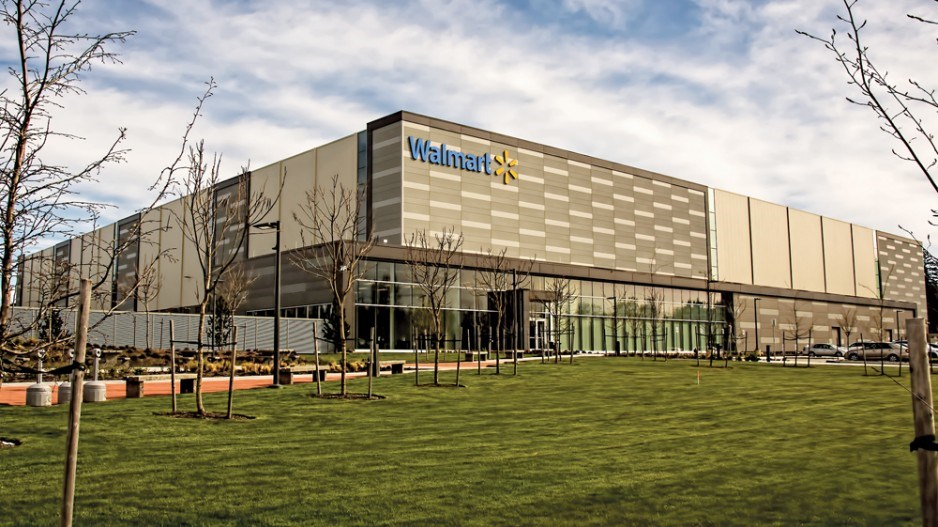With grocery supply chains under stress and inflation spiralling out of control, the good news for consumers is that grocers have been pumping billions of dollars into making operations more efficient.
Walmart spent $175 million to build a 300,000-square-foot distribution centre that opened in April in Surrey’s Campbell Heights industrial area.
That spending is part of Walmart’s projected $3.5 billion in infrastructure and efficiency upgrades across Canada between 2020 and 2025.
Competitor Sobeys did not put a price tag on its nearby 530,563-square-foot warehouse and distribution facility that opened in 2020, but the project was likely in the hundreds of millions of dollars.
“Both the Sobeys deal and the Walmart deal were contracted and committed to well before COVID-19,” Beedie’s president of industrial, Todd Yuen told BIV.
He said the pandemic sparked significant increased demand for groceries and grocery delivery.
“There’s a high probability that you’re going to see even more demand [for warehouses] from grocery groups and groups looking to deliver groceries to your home in the near future.”
Indeed, Sobeys’ parent Empire Co. Ltd. announced plans in February to build a new customer-fulfilment centre somewhere in Metro Vancouver that would open by 2025.
Grocers’ distribution centres supply stores, whereas Empire’s fulfilment centre would send orders directly to customers.
The direct-to-customer grocery delivery market is increasingly competitive, with upstart ventures such as Vancouver-founded Tiggy rapidly expanding its geographic footprint. Tiggy aims to deliver grocery orders to customers within 15 minutes of the order being placed.
Amazon.com Inc. has estimated its investment in B.C. in the past decade at more than $3 billion.
Last year, the company opened five sites in the Lower Mainland that were either fulfilment centres, delivery stations or sorting centres.
The moves intensify grocers’ battle for consumers’ food budgets, as new investments help them get products to stores faster, thereby ensuring fresher food and lower transportation costs.
Walmart’s first foray into grocery delivery in B.C. came in 2018, when it subleased about half of a 74,000-square-foot Food-X Urban Delivery-run warehouse in Burnaby to provide e-commerce deliveries to consumers.
The company ended that arrangement in 2020, when it shifted to having pickers fill orders at Walmart’s 45 B.C. stores. Drivers then delivered the food to consumers.
Much of its $3.5 billion investment into Canadian operations is to upgrade infrastructure and technology to improve store efficiency, John Bayliss, Walmart Canada’s executive vice-president of transformation told BIV.
“When 65 per cent of Canadians live within 10 minutes of a Walmart, that’s a really strong advantage for us,” he said.
Part of the value in the new Surrey distribution centre is in cutting out trucking costs and delays from having products first sent to a facility near Calgary only to be repackaged and trucked back.
Bayliss said all the beef Walmart sells is from Alberta, and the company tries to buy Canadian products as much as possible, but previous practice was to receive some produce and other items from California and Washington state at its Calgary warehouse. Workers there would repack the items to be sent to Vancouver stores.
The products are now trucked directly to Surrey from the U.S. West Coast for B.C. distribution, cutting out countless transportation hours, he said.
Sobeys similarly supplied B.C. stores from an Alberta distribution centre before it opened its Surrey site.
Despite spending US$13.7 billion to buy Whole Foods Market in 2017, Amazon is late to the food delivery game.
Whole Foods’ B.C. stores do not have e-commerce ordering. Customers can buy products in-store and have the third-party Eeko Couriers deliver the products to their homes, a Whole Foods customer service representative explained to BIV.
Amazon spokesman Dave Bauer confirmed that the company’s deliveries to customers originate at Amazon fulfilment centres and are shelf-stable products.
“I can’t say any specifics around future product launches or diversions until we’re ready to make an announcement,” he told BIV.
Other grocers with B.C. stores have long had Metro Vancouver distribution centres.
Loblaw Co. Ltd. opened a 410,000-square-foot South Surrey distribution centre in 2010. That facility handles frozen and perishable food sent to Real Canadian Superstore, No Frills, Your Independent Grocer, Shoppers Drug Mart and T&T Supermarket stores.
Save-On-Foods operates two Langley distribution centres that opened in the early 2000s and combine to have about 800,000 square feet.
Those sites supply food to stores, where pickers fill customer orders that the company delivers in its own trucks.
The Louie family’s H.Y. Louie recently rebranded its grocery business as Georgia Main Food Group.
No one at the company was available to discuss logistics for its IGA Marketplace and Fresh Street Market store banners. •



